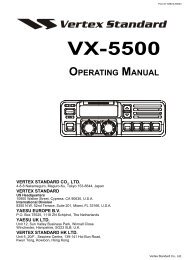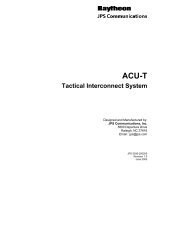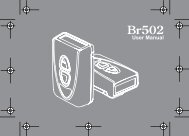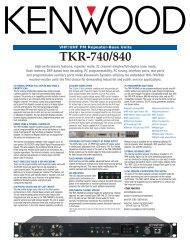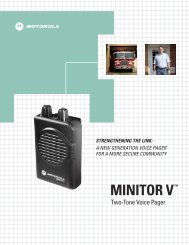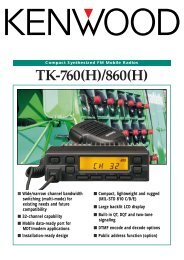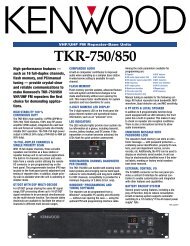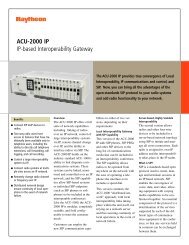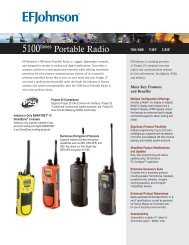DISTRIBUTED LOGIC TRUNKED RADIO SYSTEMS - Lauttamus ...
DISTRIBUTED LOGIC TRUNKED RADIO SYSTEMS - Lauttamus ...
DISTRIBUTED LOGIC TRUNKED RADIO SYSTEMS - Lauttamus ...
You also want an ePaper? Increase the reach of your titles
YUMPU automatically turns print PDFs into web optimized ePapers that Google loves.
<strong>DISTRIBUTED</strong> <strong>LOGIC</strong> <strong>TRUNKED</strong><strong>RADIO</strong> <strong>SYSTEMS</strong>AKenwood U.S.A. CorporationCommunications Division3975 Johns Creek Court, Suite 300Suwanee, GA 30024678-474-4700 voice 1-800-TRUNKING 678-474-4730 fax
2General:This paper has two purposes: First, it describes the fundamental concepts of modernanalog Trunked Radio Systems, their features and differences compared to conventionalradio systems and it provides some guidelines for maximizing a trunked radio system’sperformance. This fundamental information is intended for non-radio professionals, thosepersons with administrative or technical management backgrounds.Second, this paper goes into detail explaining the functional and technical aspects of theDistributed Logic approach used by Kenwood in designing and constructing trunked radiosystems. This detailed technical information, specifically intended for radio professionals,describes the system logic and the operation of the trunked system and subscriber units.Many system-specific features are available to customize a system or to create wide areanetworks. For additional information or system design assistance, call Kenwood U.S.A.Corp. – Communications Division at 1-800-TRUNKING (or 678-474-4700).Trunked Radio Systems, an Overview:In conventional radio systems, a group of mobiles occupies a single radio channel.When units need to communicate, this single channel carries their traffic. This channelusually remains idle for many hours each day with only a few minutes of actual traffictime.To use this single channel more efficiently, unrelated groups of users often share aconventional channel. Although several groups of users can usually co-exist on thesame channel, as their numbers increase so do interference and contention betweenunits. In practice, only a small number of user groups can be assigned to eachconventional channel before contention renders the channel useless. Since eachchannel still has significant idle periods, a conventional radio system is a very inefficientuse of the channel’s possible airtime, even when heavily loaded. There is no privacy inconventional radio systems, since all users can hear all others as they monitor thechannel for traffic already in progress before transmitting (an FCC requirement intendedto minimize contention).To improve spectral efficiency by maximizing the use of available airtime, a means ofcoordinating many users onto a group of channels was developed. These users operateon a non-interfering basis in a ‘trunked’ architecture similar in concept to the PublicSwitched Telephone Network (PSTN). Using this concept, a mobile can be transparentlyassigned to any channel in a pool of idle channels for his traffic, remaining free ofinterference or contention with other users. This coordination of frequency-agile mobilesand intelligent repeater stations is a Trunked Radio System.The trunking concept is based on the probability that in a multi-channel system not allchannels will be in use at the same time.....and not all users will need to be transmittingat the same time. A mobile unit that is automatically informed of available repeaters (orinformed of which repeater is calling), then automatically switched to that channel, has amuch greater chance of obtaining a channel when needed (a greatly reduced probabilityof contention or call blocking). In this manner, a limited number of trunk channels canaccommodate a very large number of end users. Trunking allows easier communicationflow for the user while greatly increasing channel efficiency over conventional systems.One approach to trunking uses existing conventional repeaters. These systems’ controllogic depends on the subscriber units themselves, with the mobiles constantly scanningconventional repeaters for available traffic channels or for inbound calls. These systemsKENWOOD U.S.A. CORPORATION – COMMUNICATIONS DIVISION678-474-4700 voice 1-800-TRUNKING 678-474-4730 fax
3are defined as ‘de-centralized trunking’ and are characterized by the lack of arequirement for all repeaters to be co-located, by compromises in features, loadingcapabilities and speed as well as by their lower cost. Feature sets and capabilities arelargely determined by aftermarket boards added to the subscriber units. This can createmodel-specific or aftermarket board-specific risks to the system’s configuration and to thesystem’s overall performance characteristics. Scan-based trunking systems are widelyused overseas where limited resources may be the primary determining factor of asystem’s performance characteristics. Scan-based de-centralized trunking approachesare outside the scope of this paper.There are two basic ‘centralized trunking’ system architectures, those using high speeddata on a dedicated control channel and those using low speed sub-audible data on allsystem channels to assign their subscriber units to available traffic channels. Both typescan accommodate normal two-way radio traffic as well as interconnection betweensubscriber units and the Public Switched Telephone Network (PSTN). These two modesof operation are referred to as ‘dispatch’ and ‘interconnect,’ respectively. Centralizedtrunking systems are characterized by their co-location of all channels, their speed,channel loading capabilities and extensive feature sets as well as by their higher cost.Both types are presented in the discussions that follow.Groups of users on a trunking system are known as ‘Talkgroups’ or as ‘Fleets’ and‘Subfleets.’ A talkgroup or subfleet is the virtual equivalent of a private radio channel in aconventional system. Talkgroups can be configured in various hierarchies to permitgroup calls, group paging or to allow supervisors to hear all traffic on several unrelatedworkers’ talkgroups. Talkgroups can be organized into virtual ‘Systems’ within the radio’sprogramming, allowing related talkgroups to be grouped together for simplicity. Systemscan also be programmed in the radio to allow the radio to access multiple physicalsystems, for example, a local system at a plant and a wide area system located on amountaintop. Subscriber units have the capability to scan between talkgroups andsystems, allowing tremendous flexibility to custom-configure the ‘personality’ of thetrunked radio system as a whole. A trunking system is inherently private, with radioshearing only their intended talkgroups.Frequencies assigned for 800 MHz and 900 MHz trunking systems in the USA havehistorically been exclusive assignments, free of competing co-channel users within adefined geographic area. As exclusive assignments, all assigned channels in thetrunking system can be used on an equal basis. A trunking system with exclusivechannel assignments is considered ‘fully loaded’ when 80 end users per channel areassigned to the system. For example, in a 5-channel system, the system would beconsidered fully loaded when 400 end users are loaded onto the system.Depending on traffic patterns and the end-users’ operating techniques, it may be possibleto load more end users onto a system…..or a channel loaded to the point of gridlock mayactually have fewer users. The use of interconnect on a system generally tends to lowerthe maximum possible number of users; the use of alternative data communicationtechniques, such as Kenwood’s FleetSync, tends to allow more users on a channel. Thenegative impact of interconnect on loading numbers or the positive impact of FleetSync,can be dramatic. This impact must be carefully considered in for-profit trunking systemswhose revenue stream is directly dependent on the number of end users loaded onto asystem.Although 800 MHz and 900 MHz trunking systems enjoy exclusive channel assignments,frequencies used for trunking systems at VHF and UHF are typically a mix of bothexclusive and non-exclusive (shared) channels. Non-exclusive channels carry with themthe requirement to not cause harmful interference to others already using the channel.Because of this, the FCC requires that these non-exclusive channels be monitored forother traffic before the trunking system assigns its users to the channel and they beginKENWOOD U.S.A. CORPORATION – COMMUNICATIONS DIVISION678-474-4700 voice 1-800-TRUNKING 678-474-4730 fax
5Modern Analog Trunked Radio Systems:The following discussions present the basic concepts of the two different approaches tomodern analog centralized trunked radio systems: Control channel-based trunkingsystems and distributed logic trunking systems. Both types are presented in comparisonto provide a comprehensive understanding of their relative benefits and to allow rapidrecognition of the two types. Digital trunking systems are outside the scope of this paper.Control Channel-Based Trunking Systems:In control channel-based systems, one channel is dedicated to high speed system controldata, making only 4 channels of a 5-channel system (for example) actually available forvoice traffic. Control channel-based systems use one central controller to manage theremaining traffic channels. Because all exchanges in a conversation between units occuron a single assigned traffic channel for the duration of the entire message, these systemsare referred to as ‘message-trunked’ systems.In message-trunked systems, all mobiles constantly monitor the control channel until theyare assigned to an idle traffic channel. This assignment to a traffic channel is in responseto a channel access request initiated by one of the subfleet’s mobiles or by a wirelinecontrol command from a dispatch console. A mobile requests channel access bytransmitting its request as a data exchange on the control channel’s inbound frequency.Depending on the system’s loading at that time and on the mobile’s pre-determinedimportance in the system hierarchy, the mobile may be granted a channel immediately ormay be placed into a queue for channels as they become available.Once a traffic channel assignment is granted and mobiles who are members of therequesting unit’s subfleet are grouped together on the selected free channel, therequesting mobile is notified by a beep from the system. Upon hearing the ‘proceed’beep, the end user re-keys his transmitter and the conversation begins. Depending onthe system’s loading and the user’s placement in the system’s queue, the time requiredfor assignment to a traffic channel can vary greatly from a fraction of a second to tens ofseconds.Once assigned to a traffic channel, the subfleet’s mobiles remain on this assignedchannel during all exchanges in the entire conversation and through the idle ‘hang time’of the repeater, the time during which the repeater remains transmitting as it waits foranother exchange of conversation. Hang time is dead air time required in the controlchannel-based architecture, but is unusable for other system traffic as the systemanticipates follow-on traffic within the active subfleet. Depending on traffic patterns, thehang timer can greatly impact the system’s total available air time if set improperly.The traffic channel operates much the same as a conventional carrier-squelch repeateruntil the repeater’s hang timer is exceeded. When the hang timer expires because of themobiles’ inactivity, the system assumes the mobiles have finished their traffic and it finallyunkeys the traffic channel’s transmitter. As the mobiles detect the loss of the repeater’ssignal on the assigned traffic channel, they automatically begin scanning the pool ofchannels in the trunking system to identify and revert back to the control channel to awaitfurther instructions. If an end user in the active subfleet delays its response (answering aquestion, for example) and exceeds the hang timer, another request for service must bemade to the trunking system, another traffic channel assignment must be made and thecycle is repeated.KENWOOD U.S.A. CORPORATION – COMMUNICATIONS DIVISION678-474-4700 voice 1-800-TRUNKING 678-474-4730 fax
7Distributed Logic Trunking Systems:The other approach to analog trunking, known to Kenwood as Distributed Logic Trunking,uses sub-audible data transmitted on all channels for its system control, thereby makingall channels available for coexistent, simultaneous voice traffic. Each portion of aconversation exchange occupies a traffic channel for only the duration of the exchangeitself; end users may seamlessly receive multiple traffic channel assignments during thecourse of a complete conversation. This architecture is referred to as a ‘transmissiontrunked’system.In transmission-trunked systems, each channel operates for only the length of a singletransmission (no wasted hang time) in the dispatch mode. However, since aninterconnect mobile must remain on the same channel as its physical PSTN telephoneline, interconnect traffic operates in a message-trunked mode. Variations of interconnectservice allow such functions as autodial upon PTT, call restriction (different levels ofusers have different interconnect calling privileges), one-way and two-way paging, andmanual and automatic dispatch networking.The distributed logic trunking format accommodates a total of 20 channels per systemand provides simultaneous voice traffic on all channels by allowing its sub-audible controldata to co-exist with voice traffic. Kenwood distributed logic trunking products arecompatible with all open-architecture LTR ® format products (LTR ® is a registeredtrademark of E. F. Johnson Company).In a distributed logic format, one trunking logic controller is required per RF channel. Inthis system architecture, the intelligence is ‘distributed’ between all channels, minimizingthe risk of a single-point failure crippling the entire system. The trunking controllersperform all trunking logic processing to and from the mobiles and between othercontrollers within the same system. Subscriber units in distributed logic trunking systemsare feature-rich, since the system’s intelligence is shared between the subscriber unitsand the trunking system itself.Since the system’s intelligence is shared between its subscriber units and the trunkingsystem, dispatch consoles are interfaced over the air using control stations. Because ofthe requirement to transport and replicate the sub-audible data over phone lines or RFlinks (circuits with 300 Hz–3 kHz audio bandwidth limitations), distributed logic trunkingsystems are not generally candidates for signal-to-noise voting. A new voting productmanufactured by JPS Communications uses DSP techniques to shift the sub-audibledata up into the audio circuit’s passband for transport, then shift it back to sub-audibleand recover and replicate it at the trunking system as the voted output.A system operator may have one or more systems to provide coverage over a widegeographical area. These systems can be used individually or can be networkedtogether to enable users on different systems to talk with each other. This networkingrequires the installation of one or more network switches, similar in concept to anautomatic telephone PBX. A recent enhancement of the distributed logic protocol isTrident MicroSystem’s PassPort protocol. PassPort, a complex and feature-richnetworking architecture, is outside the scope of this paper.KENWOOD U.S.A. CORPORATION – COMMUNICATIONS DIVISION678-474-4700 voice 1-800-TRUNKING 678-474-4730 fax
8Distributed Logic Trunking Technical Details:In distributed logic trunking systems, mobiles are ‘homed’ to a specific RF channel. Thishome channel is their default channel and will be used if it is not busy with other traffic. Ifthe mobile’s home channel is busy, the trunking system will trunk the mobiles to a freechannel within the system, continually reassigning the mobiles as necessary followingeach segment of the conversation exchange. It is important to note that any channelsassigned as home channels must be exclusive-use channels. Trunk-to channels (thenon-home channels in the trunking pool) may be either exclusive or shared channels.Controllers within a system are linked together via a high speed repeater data bus. Thisbus allows all system repeaters to know the current status of all other system repeaters(free or busy) and also identifies which mobile talkgroup is currently using which repeater.This data bus is a synchronized serial bus divided into 20 repeater time slots, one IDvalidation time slot and one spare (unused) time slot. Each repeater in the system (20maximum) continually updates the bus by placing the Home Channel ID of the mobilecurrently using the repeater in its own time slot on the bus. Each controller also readsthe data in all the other 19 repeater time slots to find out if one of its mobiles (a mobilehomed to this repeater) is using another repeater (has been trunked to another availablechannel).If it finds one of its own mobiles, this data is transmitted out as collection data so thatother mobiles listening with the same home channel and ID will be sent to the non-home(trunk-to) repeater to receive their call. Additionally, free repeater information iscontinually shared to all controllers so that all transmitted data contains free repeaterinformation. This updates idle mobiles so that they always know which repeater isavailable to make a call.Interaction between trunked mobiles and a distributed logic trunked repeater system isaccomplished through the use of continuous sub-audible data messages or data packets.Being sub-audible, they are transparent to the radio user and co-exist with voice traffic.Microprocessors in the mobiles interpret these data messages and use them to controlchannel switching, transmission and audio muting.Each distributed logic data packet is divided into synchronization bits, the area bit, go-toinstructions, home channel information, ID code information, free channel information anda calculated cyclic redundancy check number. Inbound data packets and outbound datapackets are the same length: 40 bits, each bit 3.3 mSec in length for a total of 132 mSecper data packet (or approximately 300 bps). In the following example, all bits (with theexception of the fixed sync bits) are illustrated as 1s:SYNC AREA GO-TO HOME ID CODE FREE CHAN CRC101011000 | 1 | 11111 | 11111 | 11111111 | 11111 | 1111111(fixed sync msg) 1 or 0 5 bits 5 bits 8 bits 5 bits 7 bits(Word length = 40 bits total.)KENWOOD U.S.A. CORPORATION – COMMUNICATIONS DIVISION678-474-4700 voice 1-800-TRUNKING 678-474-4730 fax
9The sub-audible data format is a unique, non-repetitive waveform as illustrated below.Transmitted data deviation on wideband channels is + 1.0 kHz; data deviation onnarrowband channels is + 800 Hz:Notice the small peaks on the leading and trailing edges of the series of 1s at the centerof the graticule in the example above. It is crucial in balancing a transmitter’s modulatorthat these peaks, sometimes referred to as ‘Batman’s Ears,’ are as close to the samelevel as possible (are directly across from each other horizontally). This ensures thetransmitter is optimized to accurately transmit the ultra-low frequency components of thedistributed logic waveform, thereby accommodating any areas of sustained 1s and 0sthat may appear in the data.There are five data packet types.Mobile-to-Repeater:REQ (Request for Service): requests and maintains access on a system channel.EOT (End of Transmission-Mobile): signifies the end of a mobile’s transmission.Repeater-to-Mobile:COL (Collection): responds to a REQ and collects all called mobiles tothe repeater.EOT (End of Transmission-Repeater): signifies the end of transmission tothe mobile.IDLE: sent once every ten seconds when a repeater is inactive (optional).The mobile listens on its home channel to data messages for inbound calls and for freerepeater information. This occurs at initial power up, in standby mode and after everyPTT release. Also, during scanning of multiple systems, the mobile will scan from onesystem’s home channel to the next system’s home channel ‘listening’ for calls.KENWOOD U.S.A. CORPORATION – COMMUNICATIONS DIVISION678-474-4700 voice 1-800-TRUNKING 678-474-4730 fax
10Each system can be further identified by an ‘Area Bit,’ either a 1 or a 0 set into the datastream. This area bit can be used to minimize interference from neighboring systems(area bits alternated between systems with overlapping coverage) or to improve systemsecurity by complicating unauthorized airtime access.By convention, distributed logic trunking system channels are often referred to by theirbus time slot assignments as repeater channel numbers 01 through 20. However, eachRF channel frequency pair at 800 and 900 MHz uses a three-digit ‘FCC Channel Number’to designate the assigned RF frequencies (a lookup table defined by the FCC). This FCCChannel Number (1 to 911 at 800 MHz, 1 to 399 at 900 MHz) should not be confusedwith the repeater channel numbers (01 to 20) that designate the repeater number withinthe distributed logic system.To eliminate confusion, Kenwood refers to repeater numbers with two digits (belowchannel 10), appending the system’s sync master with the letter ‘M’ (example: 01M, 02,03, etc.). At 800 and 900 MHz, channel numbers are referred to by three digits (example:001, 452, 489, etc.). Although some timing advantages still remain, early systemsrequired balancing the repeater numbers (time slots used) across the 20 available. Forexample, instead of clustering a 5 channel system together as 01M, 02, 03, 04, 05, timeslot balancing uses 01M, 05, 09, 13, 17 to equalize the gaps between bus data.Kenwood continues the legacy time slot balancing as its default system setup.Early distributed logic mobiles used a periodic idle channel packet sent by all repeaters inthe trunking system every 10 seconds (during a channel’s idle periods) to all the mobilesto confirm the system’s presence. Modern radios no longer need this idle channel packetas a periodic update during idle periods and, especially in the case of shared VHF andUHF frequencies, it is often disabled as a courtesy to co-channel users. On systemswhere the idle channel packets are active, idle channel packet activity can be animportant diagnostic tool by using a radio programmed as conventional, carrier-squelchon a site’s individual channels.The FCC requires periodic identification of transmitters, either by vocally announced callsigns or by automatically transmitting the call sign in Morse code. All modern distributedlogic controllers are capable of Morse code identification (CWID) of the channel andaccommodate normal CWID hold-off to prevent end users from hearing the CWID.Identification requirements vary; at 800 and 900 MHz only the first channel in the systemis normally identified; at VHF and UHF, all channels must be identified individually.ID Codes / Validation:Distributed logic trunking systems have a system architecture maximum of 20 channelsper physical system. Each channel in a system has a maximum of 250 talkgroup IDcodes available. This means that a 20-channel system can have a maximum of 5000 IDcodes. Groups of related users (talkgroups) are assigned one of these available IDcodes. Any number of users can share the same ID code and communicate with eachother.The complete talkgroup ID is specified as being the home channel plus the individual IDwithin that channel, such as 05-221: Home channel 05, ID code 221. These IDs areoften divided into usage blocks in each controller so blocks of IDs can be designated asdispatch, other blocks as interconnect, others as paging, etc.Often, the system operator finds it advantageous to pre-assign certain ID codes assystem maintenance codes (test codes) or a product demonstration codes. This allowsmaintenance or demonstration activities to take place without impacting customer traffic.KENWOOD U.S.A. CORPORATION – COMMUNICATIONS DIVISION678-474-4700 voice 1-800-TRUNKING 678-474-4730 fax
11By convention, Kenwood uses ID code 100 as dispatch test, ID code 200 as interconnecttest and ID code 201 as interconnect test (second language voice prompts).The trunking system is capable of determining whether a requesting mobile is authorizedto use the system. This process is called ‘validation’ and is intended to prevent theft ofservice. Mobiles are identified in the system by their area bit, home channel and ID code.If the validating controller (the controller designated as the sync master) confirms in itsdatabase that the ID is authorized to use the repeater (the ID is valid), the talkgroup’smembers are assembled and communication takes place normally.If the validating controller detects an invalid ID, the logic unit places the invalid Home#and ID# into time slot 21 of the data bus. This information is shared with all other logiccontrollers in the system. If the invalid mobile attempts to access any repeater, therepeater will transmit end-of-transmission data packets which cause the other mobiles inthis invalid talkgroup to squelch their audio and return to the standby mode. Although thecontroller handshakes normally with the invalid mobile requesting service, its repeataudio is inhibited and is not transmitted. These two measures prevent unauthorizedcommunication, despite the best efforts of experienced system hackers. Validation canbe toggled on or off in the controller on a per-ID basis, allowing the system operator tocontrol which subscriber talkgroups are authorized to use the system. This is especiallyuseful in controlling non-paying customers’ unauthorized use of commercial for-profitsystems.An advanced-technology system which assigns unique individual ID numbers to eachsubscriber unit can provide security against airtime piracy on an individual user basis.This protects the for-profit commercial system owner against unauthorized access byunscrupulous users who claim to have only a few units, but who have instead cloned alarge number of units. This system uses unique, imbedded 10-digit Electronic SerialNumbers and is referred to as ESN Validation. In recent years, however, ESN Validationand the controllers that used it have been replaced by PassPort systems which also usetheir own version of individual unit ESN Validation.Typical Dispatch Operation:In general, a dispatch ID code is assigned to an individual talkgroup. These individualtalkgroups may also be thought of as ‘private channels’ in a virtual sense. If the mobile isto communicate with several talkgroups, then it will be programmed with appropriate IDcodes for each talkgroup.For dispatch calls, the user selects the desired ID (a front-panel mnemonic such as‘SECURITY’) and presses and holds PTT to request system access. The mobileimmediately transmits a data packet on the system’s pre-designated free channel that isreceived and decoded by that channel’s controller, which in turn communicates with theother controllers in the system via the high speed data bus. The system encodes the IDcode and go-to instructions into its outbound data packets, assembling (‘collecting’) theother units of the talkgroup onto the active channel. As this happens, the mobileacknowledges to the requesting end user that the system has granted him access andthe end user begins transmitting his voice traffic. This process is referred to as‘handshaking’ and is completed in approximately 280 mSec.A handshake confirmation tone that indicates system access has been granted (knownas a ‘proceed’ or ‘go-ahead’ beep) is often used with distributed logic systems. When theend user first keys his microphone, the proceed beep is heard in the mobile’s speakeraudio 280 mSec later and the end user begins his transmission. Only one PTT action isKENWOOD U.S.A. CORPORATION – COMMUNICATIONS DIVISION678-474-4700 voice 1-800-TRUNKING 678-474-4730 fax
12required (rather than the two required in control channel-based systems); end userinstructions when the proceed beep is enabled are simple: ‘Talk after the beep.’This handshaking process is duplicated when the called mobile unit responds to thecaller. In transmission-trunked systems, portions of a dispatch conversation exchangemay occur on a different repeater in the system, the system constantly reassigningrepeaters as needed, and doing so transparently to end users.If all channels in the system are busy with traffic, a ‘busy’ indication is displayed on themobile and its PTT is inhibited. If the mobile rekeys his transmitter a few seconds later, itis highly probable that a free channel will be available for assignment since there is nohang timer overhead and all channels are equally available for traffic. Because of thevery high statistical probability of channel access, transmission-trunked systems enjoy avery low probability of call blocking. Transmission-trunked systems are considered themost efficient form of analog trunking.If a mobile’s initial attempt to handshake with the system is unsuccessful (for example,because the mobile has ventured beyond the system’s coverage footprint), the radio willre-send the handshake REQ data packet up to 4 more times (5 attempts total) in rapidsequence while the PTT is held. If handshaking is still unsuccessful after 5 attempts, ano-service tone (a denial tone) will be heard in the mobile’s speaker.Typical Interconnect Operation:An interconnect ID (also known as RIC: Radio InterConnect) is assigned to those mobilesthat need access to the local PSTN. This gives the mobile the ability to make andreceive telephone calls. It is important to note that while all channels in a trunking systemare capable of dispatch operation, only those channels with special interconnectcontrollers are also capable of interconnect operation.For mobile-to-landline interconnect calls, the user selects an interconnect talkgroup ID (afront-panel mnemonic such as ‘PHONE’) and presses PTT. Kenwood trunked productswill attempt to access only those channels in a system that have been designated asinterconnect in the radio’s programming. Once access is made, the repeater’s controllervalidates this ID code as an interconnect ID and connects the repeater’s audio to thetelephone line. The requesting mobile hears the familiar Telco dial tone and dials thedesired number using his DTMF microphone or keypad.When the call is complete, the mobile presses ‘#’ to terminate the call or allows the call tosimply time out (the action of a mobile inactivity timer). If a call’s length approaches theallowable time limit for the privileges assigned to this ID code, a beep notifies the mobilehis time is about to expire, then a few seconds later a voice prompt notifies him that thecall timer has been exceeded and the interconnect call has been terminated.For landline-to-mobile calls, the interconnect controller is called like a normal telephone.When the controller answers, it voice-prompts the caller to overdial the mobile’s ID code(for example, 05221 for talkgroup 05-221). The mobile hears a telephone-like ‘ring’ fromthe radio’s speaker to indicate the incoming call, presses PTT to respond, and the callproceeds normally. Full duplex mobiles (a rarity today) allow conversations to proceedjust like a landline call; half-duplex mobiles require a PTT from the mobile when thetrunking system end user wishes to talk to the landline caller.Several fixed and variable timers are available to manage the airtime used on a per-IDbasis. Variable timers can be used to monitor overall system loading and dynamicallyadjust the maximum time allowed for interconnect calls during periods of high dispatchKENWOOD U.S.A. CORPORATION – COMMUNICATIONS DIVISION678-474-4700 voice 1-800-TRUNKING 678-474-4730 fax
13traffic. Alternating timers can be used to allow longer call time (fixed length increments)during evenings or weekends.In addition, call records may be downloaded from the system controllers to be used inmanual accounting or billing of airtime per ID code. This important feature allows asystem operator to identify those users who may be abusing their interconnect privileges,or allows departmental or end-user billing for their share of system operating costs. Infor-profit commercial systems, this feature is normally coupled with a comprehensivebilling software package to provide the system owner’s billing and revenue stream fromthe trunking system.Kenwood KSG-11050 interconnect controllers prompt the end users using tones whileKSG-11100, KSG-11120 and KSG-12049 interconnect controllers prompt end users withdigitally stored voice audio. The KSG-11120 also provides pre-recorded bi-lingual voiceprompts, assignable on a per-ID basis. By using the KSG-12049 controller, the systemoperator can record his own custom voice prompts, changeable at any time.Using KSG-11120 or KSG-12049 controllers, it is also possible to use 4-wire DID (DirectInward Dialing) lines which directly signal the controller for the proper mobile ID. Thisprovides direct dialing and does not require the caller to overdial the ID code (eachInterconnect ID has its unique phone number). Additionally, KSG-11050, KSG-11100,KSG-11120 and KSG-11049 interconnect controllers may be configured to use 4-wireE&M control circuits.Programming Subscriber Units:Mobiles and portables typically have programming arranged to accommodate multiplesystems, each system with multiple talkgroup IDs. Since a mobile can have more thanone ID per system, a function known as Group Scan can be enabled in the mobile so thatall the selectable IDs are scanned when listening to the system’s home channel. Themobile can now receive a call from any of the programmed groups. Group Scan isenabled in the mobile on a per-system basis and operates independently of System Scan(i.e., the mobile can Group Scan independently of whether or not it is System Scanning).Trunked mobiles normally Group Scan only if the microphone is on-hook (unlessprogrammed to enable off-hook Group Scan). If the mic is off-hook, then only theselected group is decoded. However, if the Interval Scan feature is enabled, Group Scanoccurs regardless of the mic hookswitch status. Kenwood portables Group Scan all thetime (if enabled), since there is no hookswitch on a portable. These portables have aGroup Lockout feature that allows individual groups to be deleted from the Group Scanlist, if desired.Mobiles and portables can be programmed with multiple systems. Systems may have asmany as 20 channels each and are often located to provide coverage of specificgeographic areas. For wide area coverage, many systems may be built to cover adjacentareas, often having overlapping coverage. The mobile can be programmed for any or allof these systems so that communication is available over a wide area. Systems mayalso be programmed as convenience groupings of related talkgroups on the samephysical trunking system.System Scan allows a mobile to scan these individual systems, since a call could comethrough any of the programmed systems. When System Scanning, the mobile will scanfrom home channel to home channel, listening for calls. If Group Scan is also enabled,the mobile will scan for all group IDs as it checks the home channel of each systemscanned.KENWOOD U.S.A. CORPORATION – COMMUNICATIONS DIVISION678-474-4700 voice 1-800-TRUNKING 678-474-4730 fax
14As a mobile scans from home channel to home channel during System Scan, it will stop ifit detects carrier for a short time period of three data packets in length (for example).This is done to make reasonably sure that it will detect a call during this time window(finding a matching data packet, if one exists). However, this is not always foolproof. Forexample, a busy system of 20 channels could have as many as 20 data packets comingfrom a home channel data packet stream (1 packet is the mobile currently using thehome channel, plus 19 additional packets coming off the system data bus because ofother trunked mobiles). If, for example, the calling packet is 11th in the data packetstream and the mobile stops for only three data packets, it could miss the call until itsscanning sequence returns it to this channel for an additional scan period.Scan Weight is a programmable feature in the mobile that allows the mobile to listenlonger for a call. By increasing the Scan Weight, the probability of missing a call isgreatly minimized. Although Group Scan occurs very quickly, System Scan issignificantly slower because of the dwell time required to examine the serial contents ofthe home channels’ data packet streams.Mobile Data Applications:Mobile data applications can significantly reduce a system’s airtime requirements (or,conversely, increase the maximum loading possible) by offloading lengthy voice trafficexchanges onto the data system. What might otherwise be a 20 second exchange ofvoice traffic between two units can instead require only a few milliseconds as a mobiledata exchange. Examples of mobile data systems are MDT systems, remote meterreading systems, GPS systems, FleetSync, etc. Typical wideband data speeds are 2400bps; typical narrowband data speeds are 1200 bps. Mobile data traffic is inband audioand is handled transparently by the trunking system’s repeaters.Mobile data traffic can co-exist with voice traffic on an equal, non-interfering basis indistributed logic trunking systems. In such applications, the mobile data traffic is simplyassigned an ID code in the trunking system. Channel handshakes, access and dataexchanges occur just as with voice traffic.Unfortunately, mobile data traffic operating as an ID code on a distributed logic trunkingsystem still requires a 280 mSec system access time, just as with voice traffic. If onlysmall numbers of data messages take place during a day, this timing overhead is notusually a problem. However, if large numbers of data messages are to be exchanged,the channel access time can quickly become significant, especially considering that theactual data traffic may itself be only a few milliseconds in length or only a fraction of thechannel access time overhead requirement.Although there are no ironclad rules, in some cases it may be more efficient to take oneof the trunking system’s channels and convert it to conventional channel exclusively formobile data. In this case, conventional channel access by data units would typicallyrequire only 10-20 mSec, greatly improving the data throughput speeds and, byoffloading the data traffic from the trunking channels, further increases the loadingcapabilities of the trunking system’s remaining voice channels.KENWOOD U.S.A. CORPORATION – COMMUNICATIONS DIVISION678-474-4700 voice 1-800-TRUNKING 678-474-4730 fax
15End-User Migration from Conventional to Trunking:A new trunking system can sometimes be installed and commissioned from scratch usingpreviously unused frequencies. In this case, all end-users can begin using new trunkedsubscriber units at the same time. However, when several conventional channelscurrently operating as community repeaters are re-licensed and combined into a newtrunking system, it is sometimes necessary (especially in for-profit systems) toaccommodate both legacy conventional users as well as new trunked users on theresulting group of frequencies.Because of the increased efficiencies of trunking, the system operator benefits greatly byconverting all end-users to the trunking format as rapidly as possible, thereby maximizinghis available airtime. In reality, there may be some users reluctant to purchase newtrunked radios who may want to continue as conventional users indefinitely. Thissituation often occurs when groups of end-users (individual companies, for example) owntheir subscriber units and do not immediately upgrade to new trunked units.This creates the dilemma of the frequency as a valuable resource in the new trunkingsystem vs. the value of the customer’s continued business. To solve this dilemma andprovide a migration path for the end users, modern distributed logic trunking controllersallow conventional CTCSS or DCS coding to be programmed as an overlay block in theID code assignment matrix. This allows the existing conventional users’ traffic to berecognized and processed by the trunking controller as if it were a conventionalcontroller. With the possible exception of reverse-burst squelch tail elimination (there areseveral standards in use in the industry), most end-users are unaware of any differences.Programming methodologies vary; refer to individual controller operation andprogramming manuals for details.It is important that any conventional users are assigned only to trunk-to channels, not tochannels used as home channels in the trunking system. Stated conversely, anychannels in the new trunking system that will continue to have conventional users cannotbe used as home channels in the new trunking system.....until the legacy conventionalusers on these channels have migrated to trunking. It is also important that no newconventional users are assigned to the new trunking system; all new users must betrunking users.If trunking users were homed to a channel that also had conventional users programmedto it, a serious conflict would exist during the period in which the conventional user isusing the channel. When the conventional traffic is using the channel, the channelcontains the conventional user’s CTCSS or DCS coding and lacks the LTR sub-audibledata stream. Since the home channel is a trunking radio’s default channel (the channel itmonitors for assignment instructions), this has the effect of orphaning all trunking usershomed to that channel until the conventional traffic has ended. Clearly, this situationmust be avoided.But by programming the conventional users only onto trunk-to channels (conversely, bynot using channels with legacy conventional users as home channels), this allows theconventional users’ traffic to co-exist in the trunking pool on a shared basis. Forexample, if a trunking user has been assigned (trunked) to one of these shared channels,the conventional user (by monitoring the channel before transmitting) must wait forchannel access just as if the channel were in use by another conventional user. Whenthe conventional user is using the shared channel, the trunking system recognizes thepresence of his traffic just as if it were an external co-channel user, it activates the RDDcircuit and temporarily removes the shared channel from the trunking pool. Thisconventional / trunking sharing on trunk-to channels allows the new trunking system toserve the needs of both the legacy conventional user as well as the new trunking user.KENWOOD U.S.A. CORPORATION – COMMUNICATIONS DIVISION678-474-4700 voice 1-800-TRUNKING 678-474-4730 fax
16RF Considerations:Although detailed discussions involving transmitters, receivers, combiners and antennasare beyond the scope of this paper, a few general guidelines can be offered:It is important to understand that because the trunking system seamlessly assignsidentical channels, all channels in a trunking system must have exactly the samecharacteristics…..audio as well as RF. It is absolutely critical that the data and the repeataudio amplitudes on each of the repeaters are set to be exactly identical and nodifferences can be detected by the end users.It is also very important that all channels in the trunking system have similar antennaapertures and radiated powers from the antenna system. This requires not only that thecombining efficiency is matched from channel to channel (the same power on eachchannel is fed to the transmit antenna), it also requires identical transmit and receiveantenna patterns.Great care must be taken to ensure adequate isolation and freedom from desense.Desense caused by improper cable routing or caused by transmit and receive antennasmounted too close to each other can be a big problem, especially on multi-channel VHFand UHF systems. Although at 800 and 900 MHz the transmit and receive frequenciesare paired and widely separated (by 45 MHz and 39 MHz, respectively), paired transmitand receive frequencies at UHF are separated by only 5 MHz (only 3 MHz in 490-512MHz). And since there is no prescribed channel pairing at VHF, these transmit andreceive frequencies can be very problematic. Only premium transmitter combiners,receiver multicouplers and preselectors should be used on multichannel systems.One of the most important system design considerations in multichannel systems at UHFand VHF is the width of the guard band between the closest transmit and receivefrequencies. For example, if a proposed system consisted of transmit frequencies at 454,454.5 and 461 MHz, the system’s receive frequencies would be at 459, 459.5 and 466MHz. Notice the very small guard band between the 454.5 MHz channel’s receivefrequency at 459.5 MHz and the 461 MHz transmit channel. It would be virtuallyimpossible to adequately filter the 461 MHz transmit channel to prevent severe desensefrom crippling the 459.5 MHz receiver and perhaps the entire receiver subsystem. As ageneral rule, 2.5 MHz of guard band is considered the minimum for proper systemoperation.Another important consideration is the presence of intermodulation products caused bycombining multiple channels together in a combiner. Although the dual isolators used inmodern transmitter combiners are excellent in helping control intermodulation, amathematical analysis should always be performed during the system planning stages toevaluate the intermodulation risk.Although individual channel duplexers may be required at VHF, duplexing the output of amultichannel transmitter combiner with the input of a receiver multicoupler should beavoided. Instead, separate transmit and receive antennas should be used, mounted sotheir physical separation provides adequate RF isolation. If mounted vertically on atower, 10’ center-to-center vertically is adequate at 800 and 900 MHz, 40’ center-tocenteris generally adequate at UHF. VHF antennas may require careful planning togroup individual transmit antennas together and locate a receive antenna 50’ (or more)above the transmit antennas. Refer to published antenna separation / isolationnomographs for horizontal mounting or for diagonal offset mounting. In all cases,carefully check the actual desense when the system is installed by using an adjustableline sampler, testing for desense with all possible combinations of receive frequenciesand transmitters keyed.KENWOOD U.S.A. CORPORATION – COMMUNICATIONS DIVISION678-474-4700 voice 1-800-TRUNKING 678-474-4730 fax
17For Additional Information:For more information on subscriber unit programming and features, refer to the serviceand programming manuals for specific radio models. Additional publications and trainingon subscriber units are available from Kenwood U.S.A. Corp., Communications Division.For assistance with system licensing, engineering, design, site acquisition or turnkeyproject management, installation and maintenance, call Kenwood U.S.A. Corp.,Communications Division at 1-800-TRUNKING (or 678-474-4700).Copyright 2002 by Kenwood U.S.A. Corporation – Communications DivisionRevised 11-12-2002 KWFKENWOOD U.S.A. CORPORATION – COMMUNICATIONS DIVISION678-474-4700 voice 1-800-TRUNKING 678-474-4730 fax



